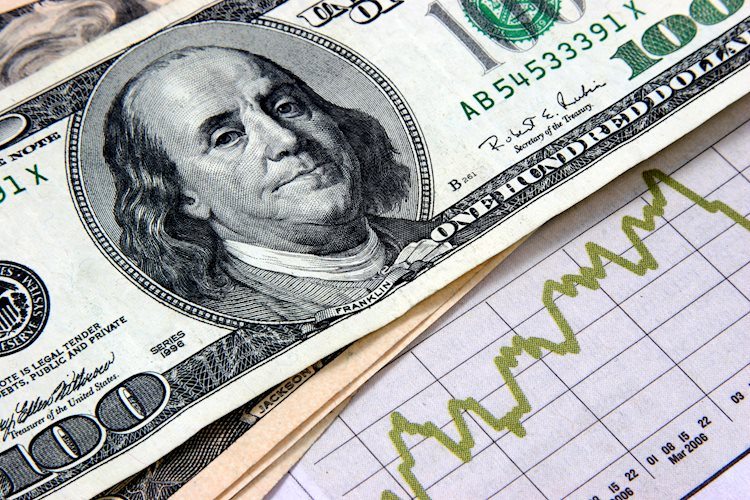- US Dollar Index declines below 108.00 on Friday, November 22.
- DXY retreats from 2-year high despite strong S&P PMI data; profit-taking and China’s stimulus package contribute to pullback.
- Fed officials remain cautious with Barkin citing inflation risks and Williams indicating potential rate reduction.
In Friday’s session, the US Dollar Index (DXY) declined slightly after reaching a new two-year high amidst geopolitical instability. However, strong S&P PMI data reinforced the US economy’s relative resilience, supporting the DXY’s gains.
The US Dollar’s pullback was attributed to profit-taking and positive economic indicators from China, including a rate reduction and a comprehensive stimulus package. Consequently, the DXY retraced from above 108.00, stabilizing around 107.50.
The DXY, which values the Greenback against a basket of major currencies, maintains a bullish bias, driven by solid economic data and a less dovish Federal Reserve (Fed) stance. Despite the retreat, the uptrend remains intact, with investors now expecting a gradual pace of rate cuts. Technical indicators suggest potential consolidation, but the overall bullish momentum remains strong.
Daily digest market movers: US Dollar holds gains after PMI data, profit-taking
- The US Dollar Index dipped after reaching a new two-year high due to geopolitical instability and profit-taking.
- The DXY found support from strong S&P PMI data indicating the US economy’s resilience.
- Positive economic news from China, such as a rate cut and stimulus package, contributed to the DXY’s pullback.
- On the data front, the US S&P Global Composite PMI rose by 1.2 points to 55.3 in November’s flash estimate.
- The S&P Global Manufacturing PMI improved marginally from 48.5 in October to 48.8 but remains in contraction.
- The S&P Global Services PMI rose notably from 55 to 57, indicating continued expansion.
DXY technical outlook: Index consolidates after reaching 108.00
The DXY has shown signs of easing after reaching 108.00 due to profit-taking by investors. Technical indicators, particularly the Relative Strength Index (RSI) and Moving Average Convergence Divergence (MACD), indicate overbought conditions, suggesting a possible slight correction in the index. Despite this, the index remains supported by strong economic data and hawkish Fed rhetoric, maintaining an overall bullish trend. The uptrend now faces resistance around 108.00 and support at 106.00-105.00, with profit-taking and risk-off sentiment potentially leading to a pullback or consolidation in the short term.
Fed FAQs
Monetary policy in the US is shaped by the Federal Reserve (Fed). The Fed has two mandates: to achieve price stability and foster full employment. Its primary tool to achieve these goals is by adjusting interest rates. When prices are rising too quickly and inflation is above the Fed’s 2% target, it raises interest rates, increasing borrowing costs throughout the economy. This results in a stronger US Dollar (USD) as it makes the US a more attractive place for international investors to park their money. When inflation falls below 2% or the Unemployment Rate is too high, the Fed may lower interest rates to encourage borrowing, which weighs on the Greenback.
The Federal Reserve (Fed) holds eight policy meetings a year, where the Federal Open Market Committee (FOMC) assesses economic conditions and makes monetary policy decisions. The FOMC is attended by twelve Fed officials – the seven members of the Board of Governors, the president of the Federal Reserve Bank of New York, and four of the remaining eleven regional Reserve Bank presidents, who serve one-year terms on a rotating basis.
In extreme situations, the Federal Reserve may resort to a policy named Quantitative Easing (QE). QE is the process by which the Fed substantially increases the flow of credit in a stuck financial system. It is a non-standard policy measure used during crises or when inflation is extremely low. It was the Fed’s weapon of choice during the Great Financial Crisis in 2008. It involves the Fed printing more Dollars and using them to buy high grade bonds from financial institutions. QE usually weakens the US Dollar.
Quantitative tightening (QT) is the reverse process of QE, whereby the Federal Reserve stops buying bonds from financial institutions and does not reinvest the principal from the bonds it holds maturing, to purchase new bonds. It is usually positive for the value of the US Dollar.
Read the full article here

